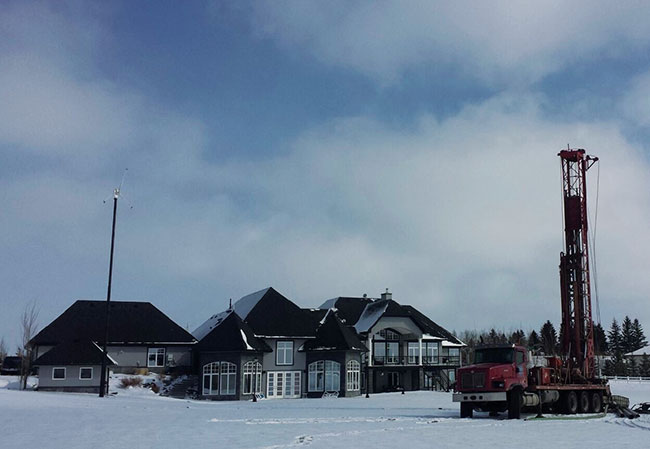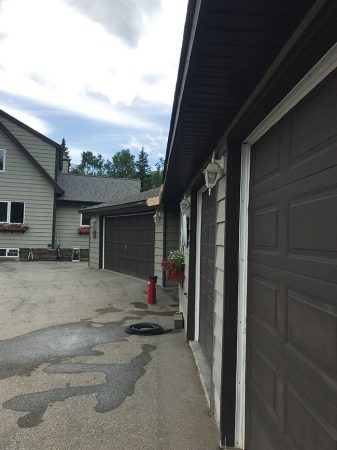
Features
Business
Drilling
Operations
Regulation & Guidelines
Sites done right
Several factors come into play when positioning a well
May 27, 2020 By Ken Hugo and Tyler Crawford
 Photo 1 shows a well installation with proper setbacks from structures. Photos courtesy Tyler Crawford of Aaron Drilling Ltd.
Photo 1 shows a well installation with proper setbacks from structures. Photos courtesy Tyler Crawford of Aaron Drilling Ltd. Drillers know either by instinct or by experience the importance of picking a good place to site a well. The well should be in a flat and dry spot that the rig can get to.
However, there is more than this to siting a well that the driller should be aware of. Regulatory setbacks are present that state where a well should not go, but besides the regulatory requirements several other parameters may be considered.
The setbacks are specified in the water well regulations that exist for most provinces and one should consult those regulations for these setbacks. For instance, Alberta and Ontario require a setback of a well of at least 15 metres from a septic field. Ontario’s Water Supply Wells Requirements and Best Practices has an extensive table (Table 4-3) on information to collect when siting a well.
Items to consider when siting a well can be broken down into four major groups:
1. WELL ACCESSIBILITY
Besides a flat and dry spot for the rig when the well is first installed, consideration needs to be made for long-term well accessibility. Property lines should be known before the well is installed; the well might not be accessible if it is placed on an adjoining property (even by mistake) and the property owner is not co-operative on letting someone service a well that supplies another lot. Wells should not be in buildings or near overhead power lines or subsurface utility lines.
While predicting the future is difficult, one must at least keep in mind when installing a new well that the well is likely to be just one of the new installations on a site, and discussion should be had with the site owner on what other facilities may be placed on the site eventually. Future landscaping should also be considered – too many wells are partially or entirely buried at sites after the landscapers have completed their work. Wells should have at least 18 inches of stickup and a vermin-proof cap.
Photo 1 shows a well installation with proper setbacks from structures. Photo 2 shows a site where the well was installed without proper consideration of future buildings. This well may need to be serviced in the future and a large rig or service truck will need to back up to the well at some point to, in a best-case scenario, change the pump, or in the worst-case scenario, change the liner, which would be inconvenient at best for this well.
One should also consider that wells may be poorly placed with respect to vehicular operation and the well should be located where it will not be hit or contacted by a motor vehicle, lawn tractor or tractor with a snow blade on it when its buried in snow.
2. DISTANCE TO SOURCES OF CONTAMINATION
As was previously discussed, setbacks from septic fields are in regulations. Other sources of contamination are often present, such as fuel tanks, manure storage, fertilizer or pesticide storage and road salts.
A scenario in Alberta developed in an area of numerous relatively small lots. Although setbacks between wells and septic fields on the lots themselves were often maintained, in frequent cases wells on one lot were found to be close to septic fields on another lot. Although it can be hard to discover what is going on in neighbouring properties, one should be aware that contaminant migration does not respect property boundaries.
While no one expects water well drillers to be contaminant hydrogeologists, they are familiar with the strata they are drilling through. Certain types of aquifers, specifically shallow aquifers that have no confining layers above them, are particularly susceptible to contamination. These aquifers, such as those under river gravels, can be quite prolific, but are also susceptible to anything from surface spills to high nutrient loading or bacteria within adjacent streams. Appreciation of these features may require a change in the amount of surface casing to ensure that water from the deepest part of the aquifer is used.

Photo 2 shows a site where the well was installed without proper consideration of future buildings. Photos courtesy Tyler Crawford of Aaron Drilling Ltd.
3. PRESENCE OF OTHER NEARBY SUPPLY WELLS
Canada is fortunate in that we don’t have many aquifers that are currently at risk of dewatering. However, it does occur on a local scale – aquifer water levels can be lowered in the vicinity of large supply wells, and efforts to place wells as far away as feasible from large supply wells may be necessary.
Even if water demands from wells in the area is not excessive, other well owners often have concerns (whether realistic or not) that a new well may restrict their water supply. Maintaining as large a distance between water supply wells as possible can go a long way to addressing these concerns.
4. FUTURE CHANGES TO SURFACE DRAINAGE CHARACTERISTICS
Re-emergence of wetlands, migration of river channels and extent of flooding are topics beyond the professional judgment of water well drillers, and even hydrologists struggle to accurately determine how far floods may extend or how river channels may migrate. Nevertheless, one should be aware when drilling in a low-lying area, or in proximity to a creek, that although it might be dry (and the landowner may state that they have been on the property for decades and that area has always been dry), future changes may occur that will submerge the well.
Effects of well submergence are beyond the scope of this article, but a well that is under flood waters will at best require disinfecting the well before it can be put back to use. Abandonment of the well and installation of a new well in a higher area may be required.
As most drillers are aware, recording the well location with a hand-held geographic positioning system (GPS) device, combined with Google air photos, is a powerful tool for illustrating the location of a well. Google allows for direct importation of well locations onto an air photo by entering the latitude and longitude of the well location. Remember, the Google air photo may be a few years old, and in sites undergoing development the air photo will not accurately depict the site. Additions to the air photo should be made to show recent buildings or roads.
Water wells are long-term installations and by applying proper well-siting techniques water well drillers can ensure their long-term use. As the local drilling contractor, you can provide information on siting issues such that well integrity will be preserved and maintenance and proper well pump installation can be undertaken to ensure the well can last 30-plus years!
Ken Hugo is senior hydrogeologist with Solstice Environmental Management in Calgary. Tyler Crawford is co-owner of Aaron Drilling Ltd. in Foothills, Alta.
Print this page